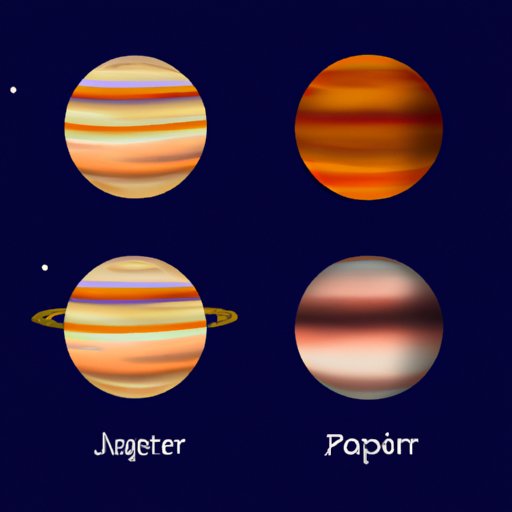Introduction
The largest planet in our solar system is a fascinating subject to explore. Jupiter’s size is unparalleled, and it plays an important role in the dynamics of our solar system. This article aims to give a comprehensive overview of Jupiter’s size, its unique features, and how it compares to other gas giants in our solar system and beyond.
Straightforward Comparison: The Largest Planet in Our Solar System
When it comes to the size of the planets, Jupiter is unequivocally the largest planet in our solar system. The table below shows the relative sizes of the planets in order:
1. Jupiter – 86,881 miles (139,822 kilometers) in diameter
2. Saturn – 72,367 miles (116,460 kilometers) in diameter
3. Uranus – 31,518 miles (50,724 kilometers) in diameter
4. Neptune – 30,599 miles (49,244 kilometers) in diameter
5. Earth – 7,926 miles (12,742 kilometers) in diameter
6. Venus – 7,520 miles (12,104 kilometers) in diameter
7. Mars – 4,217 miles (6,779 kilometers) in diameter
8. Mercury – 3,030 miles (4,880 kilometers) in diameter
From this comparison, it is clear that Jupiter is the largest planet in our solar system, accounting for more than twice the combined mass of all the other planets.
Exploring Jupiter: A Close Look at the Largest Planet
When we look at Jupiter’s size in detail, we can see that it is an incredible 318 times more massive than Earth while also having a larger diameter of more than 86,000 miles (139,822 km). To put it into perspective, Jupiter’s mass is more massive than all the other planets in our solar system combined. By volume, Jupiter will easily fit about 1,300 Earths inside it.
Aside from its size, Jupiter has some unique features that set it apart from other planets in our solar system. One of the most striking is its iconic Great Red Spot, a storm larger than the size of Earth that has been raging on its surface for more than 350 years. Additionally, Jupiter’s atmosphere is a fascinating subject of research, with its colorful bands and zones of high and low pressure systems reflecting the planet’s dynamic weather patterns.
Jupiter Among its Peers: A Closer Look at the Gas Giants in Our Solar System
While Jupiter may be the largest planet in our solar system, it is far from alone among the gas giants. Saturn, Uranus, and Neptune are other gas giants that share similar properties to Jupiter. When comparing Jupiter to its peers, it is worth noting that while Saturn is the second-largest planet in our solar system, it is less dense than Jupiter, and it takes up more volume than the largest planet.
Uranus and Neptune, on the other hand, are the only two other giant planets in the solar system that are often called “ice giants” since they are primarily composed of elements heavier than hydrogen and helium, whereas Jupiter and Saturn are primarily composed of those two gases. After tons of research, scientists have concluded that Jupiter is the largest gas giant planet and the most massive planet in our solar system.
The Evolution of the Largest Planet in Our Solar System
The formation and evolution of Jupiter are fascinating topics that scientists have been studying for years. Jupiter is believed to have formed about 4.5 billion years ago during the early formation of our solar system. Gas and dust began to collapse under gravity to form a protoplanetary disk, which eventually led to the formation of Jupiter and the other gas giants.
However, unlike the other planets in our solar system, Jupiter never grew to become a star, never ignited and never produced its energy source as a star, known as fusion. Despite Jupiter’s size and mass, whether it could still consider as a star is still a debated topic among scientists.
The Search for Super Jupiters: Beyond our Solar System
Through the years, numerous exoplanets have been discovered beyond the solar system, and many of them include gas giants that are much larger than Jupiter and referred to as “Super Jupiters”. These supermassive exoplanets, which can be thousands of light-years away, offer a unique opportunity to study the formation of gas giants and further understand our solar system’s evolution.
The first supermassive gas giant exoplanet was discovered in 1995, and since then, hundreds of others have been confirmed through the use of various techniques, including radial velocity, transit method, and direct imaging. Scientists study the atmosphere and other features of these giant exoplanets by using a variety of telescopes and analyzing spectral data, which offers an interesting insight into the characteristics and the formation of these planets.
How Jupiter’s Size Affects Other Celestial Objects in our Solar System
Jupiter’s incredibly large mass exerts a considerable gravitational force throughout our solar system. Despite its vast distance from the sun, Jupiter’s gravitational pull affects the orbits of other celestial objects, including comets, asteroids, and other planets. Jupiter’s gravity particularly affects the asteroid belt that lies between Mars and Jupiter and mainly keeps it free from much of the debris that poses a hazard to spacecraft and Earth.
Furthermore, studying gravitational interactions between Jupiter and other celestial objects canprovide further insight into planetary formation and evolution, which will help us better understand our place in the universe.
Conclusion
From this article, we can conclude that Jupiter is hands down the largest planet in our solar system, and its massive size has significant implications for both our Solar System and beyond it. Its unique features, massive size, and influence on other celestial bodies make Jupiter an essential part of the cosmos that we should continue to study and understand. By studying Jupiter and other celestial objects, we can gain more knowledge about our universe’s evolution, answer fundamental scientific questions, and possibly unlock critical solutions to the essential problems that the human race faces today.
